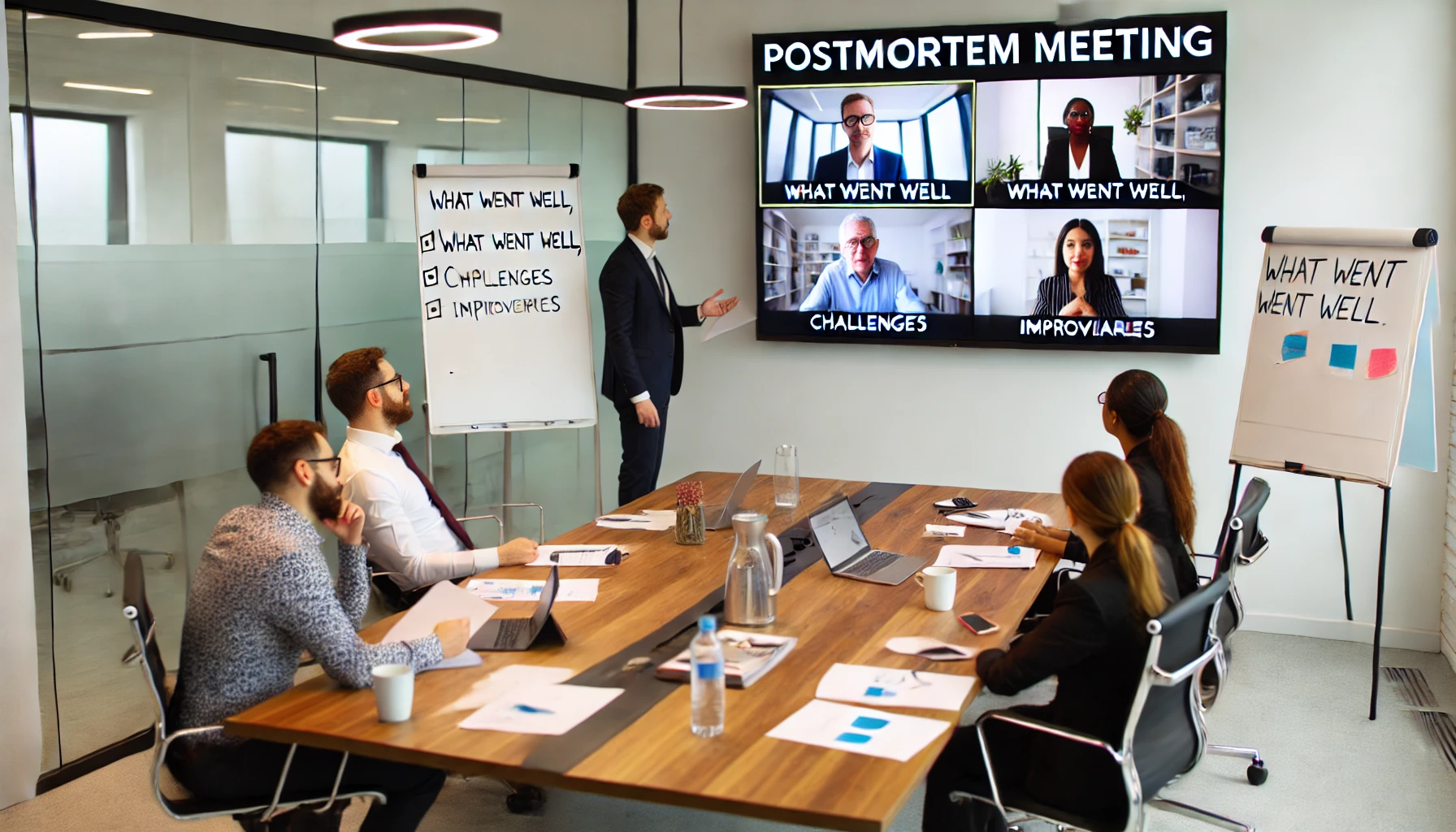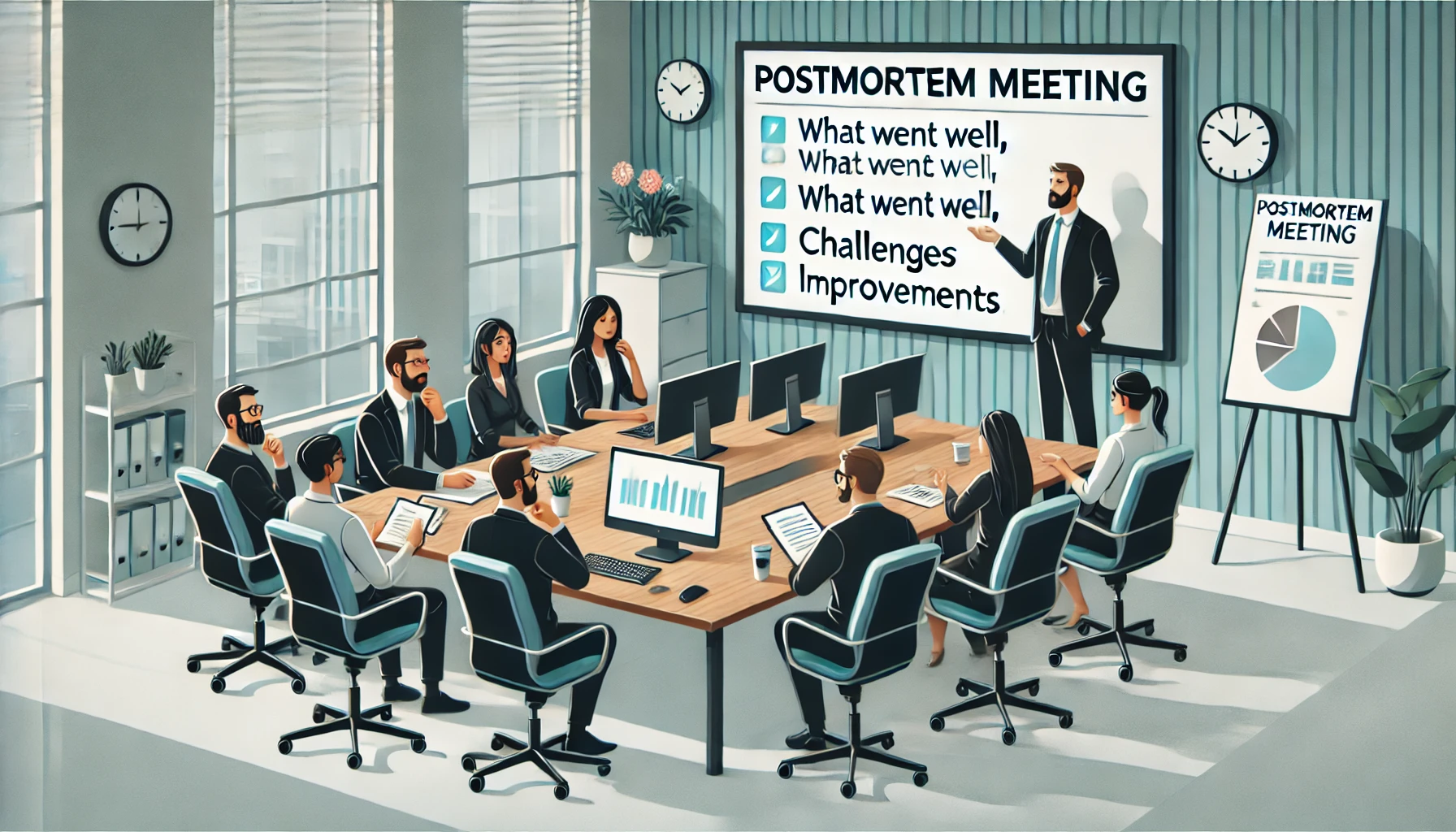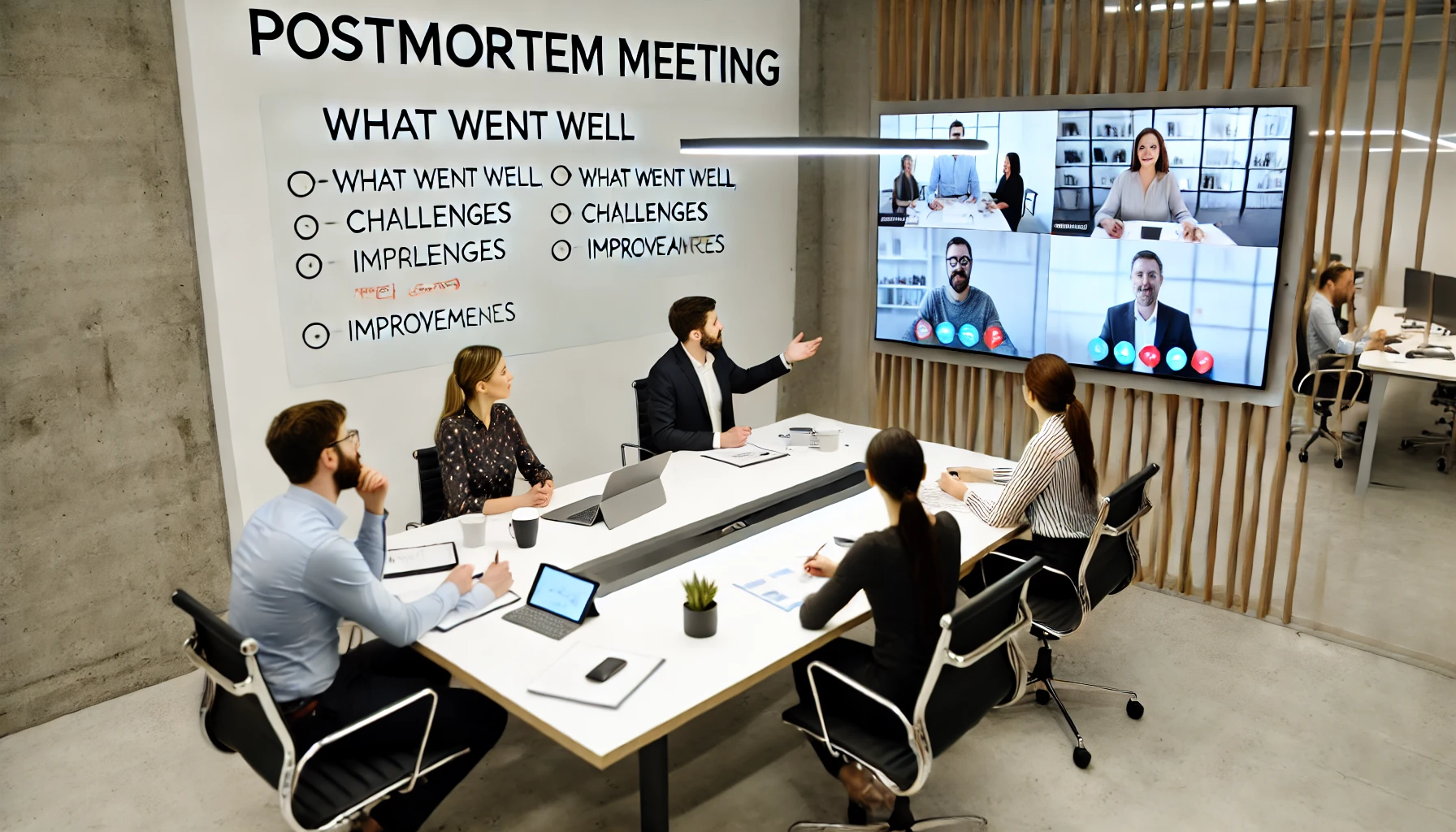You wrapped up a project and thought, “What could we’ve done differently?” right? That’s where a post mortem meeting comes into play. These meetings are invaluable for dissecting what went right, what went wrong, and how to improve for next time.
This article explains the post mortem meeting meaning and its benefits and reveals what should be covered in a post mortem meeting. Moreover, it provides steps and best practices to run a post mortem effectively.
Importantly, let’s unveil how Krisp’s AI meeting assistant can make your meetings far more productive and effective.
What Is a Post Mortem Meeting?

A post mortem meeting is a session to analyze project outcomes after a project or significant event. What is the purpose of the post mortem? These meetings aim to identify successes, failures, and areas for improvement.
Think of this meeting as a reflective process that helps teams learn and grow, ensuring better performance in future projects. Importantly, teams shouldn’t use these meetings to lay blame on members.
Instead, these gatherings should help teams assess projects’ success and failure and identify steps to improve future projects.
Post Mortem vs. Premortem
What about the difference between project post mortem and premortem meetings? As the name says, premortem meetings occur before a project starts. These meetings aim to anticipate potential failures and challenges. How?
Participants imagine that the project has failed, working backward to identify the reasons for that failure. And such a proactive approach helps teams uncover risks and plan strategies to prevent issues before they arise.
Premortem meeting benefits include enhanced foresight and risk management, increasing the likelihood of project success.
Compared, the goal of the post mortem is to learn from past experiences, identify successes and failures, and develop actionable steps for improvement.
Post mortem meetings provide valuable insights and lessons that you can use to improve future projects. We’ll discuss additional benefits below.
Post Mortem Meeting Synonym
What’s another name for a post mortem meeting? Here are different names:
-
Retrospective
This one is typical of the Agile and Scrum project management methodologies. A retrospective is about reflecting on the past iteration to improve future sprints. Project management involves planning, initiation, execution, monitoring, and closing.
Agile Project Management (APM) plans and guides project processes using smaller cycles (sprints) or iterations. And the Scrum methodology is focused on teamwork and accountability toward a well-defined goal.
Example: “In our last sprint, we delivered features on time but faced issues with code quality. How can we address this in the next sprint?”
-
Debrief
This one is common in military and emergency services. It emphasizes a thorough review of actions taken during an operation.
Specifically, debrief meetings are structured discussions about how team members worked toward achieving a common goal. The latter can include a project, event, or a significant undertaking.
Example: “Our communication was efficient during the emergency drill, but there were delays in resource deployment. How can we streamline this process?”
-
After-Action Review (AAR) or Critical Incident Review
This one is typical of military and business settings. It’s focused on evaluating what happened, why it happened, and how it can be improved next time.
During an after-action review meeting, participants discuss the objectives, processes, outcomes, and challenges. They discuss the areas for improvement, project success, best practices, and further steps.
Example: “Our product launch showed high engagement but encountered logistical issues. What were the root causes, and how can we avoid them in the future?”
-
Project Recap
A project recap post mortem focuses on reviewing the entire project lifecycle. It summarizes key events, milestones, achievements, and challenges encountered.
Moreover, it provides a comprehensive overview, helping the team understand the project’s trajectory and outcomes. Finally, this meeting highlights major project successes and areas for improvement, serving as a holistic review.
Example: “Our marketing campaign met its targets in quarter one (Q1) but faced challenges in Q2 due to budget constraints.”
-
Wrap-Up Meeting
A wrap-up meeting is held after the project to finalize loose ends and ensure all deliverables are completed.
This meeting focuses on administrative closure. Specifically, it aims to verify that all tasks are finished and discuss any final feedback. Finally, it ensures the project is formally closed, and all responsibilities are fulfilled.
Example: “Let’s confirm that client deliverables have been met and review the remaining documentation.”
-
Lessons Learned
A lessons learned postmortem meeting aims to identify valuable insights gained during the project.
The focus is on extracting actionable lessons from successes and failures. Namely, this meeting aims to document these insights to improve future projects. Thus, it fosters a culture of continuous improvement and learning, boosting team morale.
Example: “Daily stand-ups significantly improved team communication and alignment.”
What Is a Post Mortem Report? Post Mortem Report Types

A post mortem report documents the meeting outcomes, summarizing key findings, successes, failures, and actionable steps for future improvement.
What Are the Different Types of Post Mortem Reports?
The different types of post mortem reports serve as a reference for the team to understand what worked, what didn’t, and how to enhance future projects. Here are the types:
- Narrative Report: Provides a detailed meeting narrative covering all discussed points and decisions.
- Checklist Report: Offers a checklist format to highlight key discussion areas and action items.
- Root Cause Analysis Report: Serves to identify the root causes of failures and suggest solutions.
How to Use a Post Mortem Report?
The systematic use of post mortem reports allows teams to continuously improve their processes. Additionally, it enables teams to avoid repeating past mistakes and problems caused by risks.
Did you know cybercrime, IT outages, and data breaches were the leading risks for small businesses globally in 2023? And quality of labor is the most important problem for small businesses in the US in 2024.
So here we go:
- Review: Regularly revisit the report to ensure that action items are being implemented. For example, use a meeting recording software solution to record your post mortem meeting. Next, take meeting notes to create a report you can save for future reference.
- Monitor: Based on the report, track the progress of changes and improvements. For instance, create an objective summary of the meeting to create your postmortem report. Then, use the saved report to monitor the project’s progress.
- Communicate: Share the report with others to ensure transparency and collective learning. For example, consider sharing your saved meetings with team members and stakeholders so everybody is on the same page.
Benefits of Organizing Post Mortem Meetings

- Improved Business Processes: By identifying what worked and what didn’t, you can refine your business processes for better efficiency.
According to Investopedia, nearly 45% of new businesses don’t continue after the first five years. And poor market research and a lack of a proper business plan are the top reasons for business failure.
- Enhanced Communication: These meetings foster open dialogue and understanding among team members.
After all, effective communication in business management is critical to business success as it builds a company’s reputation, reduces mismanagement, and prevents poor business results.
- Increased Accountability: Discussing successes and failures helps team members take responsibility and learn from their mistakes.
Interestingly, researchers at the NeuroLeadership Institute have shown that by enhancing cognitive processes, leaders can hold their teams more accountable for their teams. And this helps teams successfully meet deadlines, hit targets, and increase revenues.
- Team Building: Reflecting on shared experiences during effective team-building activities can strengthen team bonds. Also, it helps members more easily navigate stressful times.
According to Forbes, companies with high engagement earn 21% more profit. Moreover, companies witness 17% more productivity.
Steps in a Post Mortem Business Meeting
Employees often find meetings irritating and a waste of time. That’s where meeting norms step in to make team discussions productive and engaging. These norms can include setting clear objectives and respecting different viewpoints.
So, how can you organize a post mortem meeting to quickly understand the mistakes, missteps, and successes affecting your project? Let me show you how:
Step 1: Preparation
- Gather Data: Collect relevant project data, including timelines, budgets, and notable incidents. Because valuable data collection provides valuable insights and helps strengthen decision-making.
- Invite Participants: Invite all key team members and stakeholders. Specifically, if you’re conducting an online meeting, send an invite with the meeting date and time and the meeting ID or link.
- Set a Meeting Agenda: Outline the post mortem’s goals and structure in a productive meeting agenda by prioritizing discussion topics and defining time allocations.
Step 2: During the Meeting
- Introduction: Start the meeting with a brief overview of the project’s objectives and outcomes. For instance, objectives may include “Identify Success” and “Analyze Failures.” And outcomes can include “Actionable Insights” and “Documented Lessons.”
- Review Goals: Review whether the project met its goals and objectives. Specifically, present the original goals, compare the outcomes, analyze the deviations, and learn and adjust the goals.
- Analyze Successes and Failures: Use specific examples to identify what went well and what didn’t. Compare the planned versus actual outcomes, investigate the underlying reasons for failures, and develop strategies for successful performance.
- Root Cause Analysis: Study the reasons behind successes and failures. Specifically, a root cause analysis involves listing critical problems encountered, reviewing relevant data and timelines, categorizing related issues, and developing solutions.
- Action Items: Develop actionable steps to improve future projects. Specifically, an action plan can include points like “Identify Key Areas for Improvement” and “Assign Responsibilities.”
Step 3: Follow-Up
- Document Findings: Record the meeting’s outcomes and share them with all participants. For example, Meeting Assistant Krisp can Record your post mortem meeting, Transcribe the discussions, and save the Meeting Transcription so you can share the key findings with other team members and stakeholders.
- Implement Changes: Ensure the agreed-upon improvements are integrated into future projects. Specifically, you can rely on change management practices to incorporate changes for better outcomes.
- Monitor Progress: Track the effectiveness of the changes and adjust as necessary. Namely, project progress monitoring involves steps like clarifying and adjusting project expectations.
How to Run a Post Mortem Meeting: Example Scenario

Imagine you’ve just completed a software development project. Here’s how to run your post mortem:
Preparation
- Collect data on project timelines, bug reports, and feedback from the client.
- Invite the project manager, developers, QA team, and client representatives.
- Set an agenda highlighting key discussion points, including timeline adherence, code quality, client satisfaction, and team collaboration.
During the Meeting
- Start with a brief overview: “We aimed to launch the new app version by June 1st but encountered delays.”
- Review goals: “Did we meet our objectives? What were the expectations versus the reality?”
- Analyze: “The beta testing phase went smoothly, but we had significant delays during final integration.”
- Root Cause: “What caused the integration delays? Lack of clear communication between teams.”
- Action Items: “Implement weekly cross-team check-ins to improve communication.”
Follow-Up
- Document findings and distribute them to all team members.
- Assign responsibility for implementing changes, such as scheduling the weekly check-ins.
- Monitor the next project to ensure these changes are effective.
Krisp Helps You Enhance Your Post Mortem Meeting

Have you ever participated in a five-minute meeting with only five people that was more effective and productive than an hour-long meeting with all team members?
That’s because the meeting was organized using best practices and the right technology, like Krisp, to enhance productivity. In fact, to say AI Meeting Assistant Krisp plays a considerable role in our increasingly remote world is to say nothing.
Collaboration technologies like Krisp make meetings much more equitable and effective. How? Krisp helps effortlessly overcome remote and hybrid workplace challenges like poor collaboration and weak decision-making.
Let me explain how.
How Krips Helps You Get the Most of Post Mortem Meetings
The rise of video-conferencing technologies like Zoom and Google Meet has improved access to remote meetings. Did you know that technology implemented poorly is the top enterprise technology challenge in 2024?
Thankfully, the Krisp AI Meeting Assistant is designed with productivity and efficiency in mind to revolutionize your post mortem meeting. With Krisp, the leader in Productivity Voice AI, you can easily sidestep modern workplace challenges.
Specifically, Voice AI technology like Krisp reduces noise-related issues by 78%. So, it’s no wonder that audio improvement and noise reduction take the meeting experience to the next level, eliminating stress and frustration.
How? Krisp:
- Offers automatic meeting recording software to save discussions for future reference
- Eliminates distractions in real time via its unique Noise Cancelling technology
- Transcribes Audio to Text with unmatched quality and speaker recognition
- Provides an error-free Meeting Summary via exceptionally accurate Note Taking
- Generates high-quality Follow-Up steps and Action Items in Meeting Minutes
- Enables gathering Meeting Minutes into a post mortem Meeting Template to organize meeting information better
By facilitating meeting processes, Krisp eliminates main pain points, such as miscommunication and poor decision-making.
Thus, Krisp enables you to:
- Quickly prepare a post mortem meeting agenda
- Carefully assess project successes and pitfalls
- Quickly discover insights allowing you to implement better processes for future projects
- Effortlessly overcome project challenges
- Dramatically enhance business processes
- Successfully complete your projects.
As a resuly, this intelligent Meeting Assistant enhances collaboration and communication and elevates teamwork.
Moreover, Krisp boosts meeting productivity and engagement. Naturally, such increased productivity improves our quality of life, making our lives easier.
You can use Krisp on Windows, Mac, Linux, iOS, or Android. Moreover, you can integrate Krisp with any virtual conferencing platform, including Zoom, Google Meet, and Microsoft Teams.
Best Practices for Post Mortem Meetings
Best practices represent guidelines, ethics, or ideas that help you most effectively organize your business processes. Here are post mortem meeting standards or ethical guidelines offering the best course of action in meeting organization:
- Create a Safe Environment: Encourage honest feedback by creating a safe space for honest conversations. Specifically, focus on giving permission and creating safety so people will say or ask anything. Moreover, in secure environments, people aren’t afraid to be vulnerable and speak their minds.
- Be Specific: Focus on concrete examples rather than vague feedback. Specifically, examples will support your argument, and your audience will believe it. Because evidence is critical to being specific.
- Keep It Balanced: Involve positive and negative thinking in your meeting to maintain morale for effective decision-making. Namely, negatives reduce uncertainty, and positives let us take a leap and decide.
- Use Technology to Your Advantage: For example, Krisp’s 96% accurate Note-Taking can help you create a post mortem meeting agenda template, which you can share with others to boost productivity and collaboration.
- Ensure Actionable Outcomes: For actionable and measurable outcomes, develop clear steps to address the issues identified. For example, prepare in advance, encourage everyone to share their opinions and experiences, and determine concrete and realistic actions.
- Follow-Up: Continuously monitor the implementation of improvements to ensure they are effective. For example, write an effective follow-up email after the meeting. Moreover, turn to Krisp to Record and save Meeting Transcripts that you can share with team members to enhance post-meeting follow-up.
Conclusion
A post mortem meeting is conducted at the end of a project. It helps teams ensure comprehensive project reviews, formal closures, and valuable lessons learned for project success. These meetings are essential for continuous improvement and team growth.
Importantly, Krisp Meeting Assistant can enhance your meeting post mortem by ensuring clear communication through Noise Cancellation, Meeting Recording Transcriptions, and Summaries. As a result, you can enjoy far more efficient and productive online meetings.
Frequently Asked Questions
Postmortem Meetings:
- Conducted after the completion of a project.
- Comprehensive review of the entire project lifecycle.
- Identifies successes, failures, and lessons learned.
Retrospective Meetings:
- Typical of Agile project management methodologies.
- Held at the end of each iteration or sprint in Agile methodologies.
- Focuses on the recent iteration, aiming for continuous improvement.
- Identifies what went well, what didn’t, and how to improve in the next sprint.





